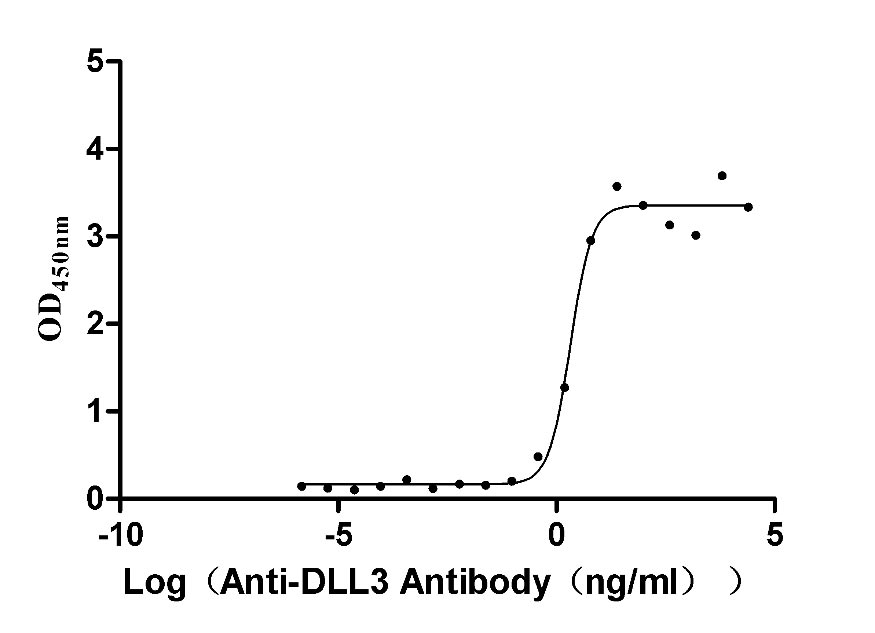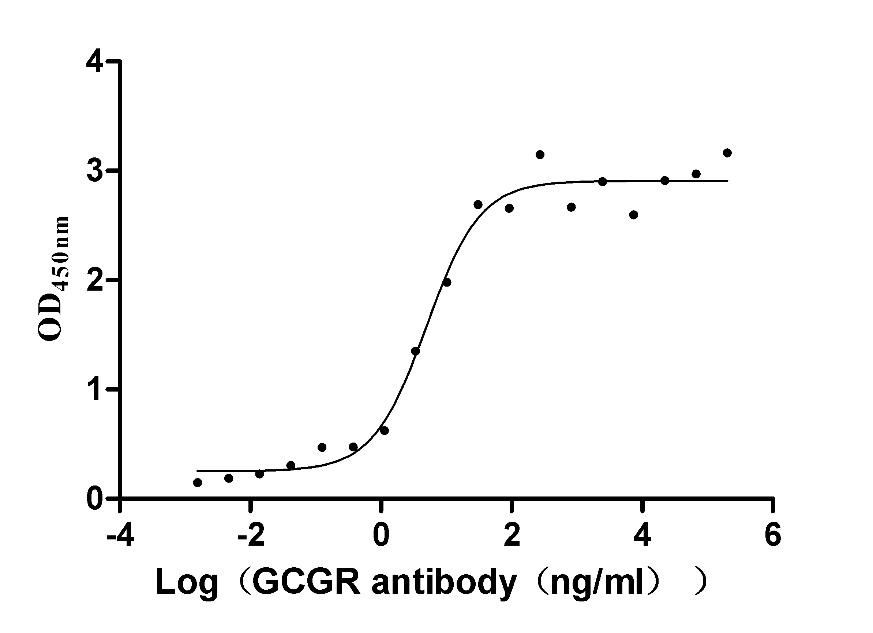Recombinant Human Synapsin-2 (SYN2)
-
货号:CSB-YP842151HU
-
规格:
-
来源:Yeast
-
其他:
-
货号:CSB-EP842151HU
-
规格:
-
来源:E.coli
-
其他:
-
货号:CSB-EP842151HU-B
-
规格:
-
来源:E.coli
-
共轭:Avi-tag Biotinylated
E. coli biotin ligase (BirA) is highly specific in covalently attaching biotin to the 15 amino acid AviTag peptide. This recombinant protein was biotinylated in vivo by AviTag-BirA technology, which method is BriA catalyzes amide linkage between the biotin and the specific lysine of the AviTag.
-
其他:
-
货号:CSB-BP842151HU
-
规格:
-
来源:Baculovirus
-
其他:
-
货号:CSB-MP842151HU
-
规格:
-
来源:Mammalian cell
-
其他:
产品详情
-
纯度:>85% (SDS-PAGE)
-
基因名:SYN2
-
Uniprot No.:
-
别名:SYN2; Synapsin-2; Synapsin II
-
种属:Homo sapiens (Human)
-
蛋白长度:full length protein
-
表达区域:1-582
-
氨基酸序列MMNFLRRRLS DSSFIANLPN GYMTDLQRPE PQQAPTPPPP GPGAASASAA PPTASPGPER TPPAASAPAP PPARTPSVGS SLFSSLSQAV KQTAASAGLV DAPGAAPAAA RKAKVLLVVD EPHADWAKCF RGKKVLGDYD IKVEQAEFSE LNLVAHADGT YAVDMQVLRN GTKVVRSFRP DFVLIRQHAF GMAENEDFRH LIIGMQYAGL PSINSLESIY NFCDKPWVFA QLVAIYKTLG GEKFPLIEQT YYPNHKEMLT LPTFPVVVKI GHAHSGMGKV KVENHYDFQD IASVVALTQT YATAEPFIDS KYDIRVQKIG NNYKAYMRTS ISGNWKTNTG SAMLEQIAMS DRYKLWVDTC SEMFGGLDIC AVKAVHGKDG KDYIFEVMDC SMPLIGEHQV EDRQLITELV ISKMNQLLSR TPALSPQRPL TTQQPQSGTL KDPDSSKTPP QRPPPQGGPG QPQGMQPPGK VLPPRRLPPG PSLPPSSSSS SSSSSSAPQR PGGPTTHGDA PSSSSSLAEA QPPLAAPPQK PQPHPQLNKS QSLTNAFSFS ESSFFRSSAN EDEAKAETIR SLRKSFASLF SD
-
蛋白标签:Tag type will be determined during the manufacturing process.
The tag type will be determined during production process. If you have specified tag type, please tell us and we will develop the specified tag preferentially. -
产品提供形式:Lyophilized powder
Note: We will preferentially ship the format that we have in stock, however, if you have any special requirement for the format, please remark your requirement when placing the order, we will prepare according to your demand. -
复溶:We recommend that this vial be briefly centrifuged prior to opening to bring the contents to the bottom. Please reconstitute protein in deionized sterile water to a concentration of 0.1-1.0 mg/mL.We recommend to add 5-50% of glycerol (final concentration) and aliquot for long-term storage at -20℃/-80℃. Our default final concentration of glycerol is 50%. Customers could use it as reference.
-
储存条件:Store at -20°C/-80°C upon receipt, aliquoting is necessary for mutiple use. Avoid repeated freeze-thaw cycles.
-
保质期:The shelf life is related to many factors, storage state, buffer ingredients, storage temperature and the stability of the protein itself.
Generally, the shelf life of liquid form is 6 months at -20°C/-80°C. The shelf life of lyophilized form is 12 months at -20°C/-80°C. -
货期:Delivery time may differ from different purchasing way or location, please kindly consult your local distributors for specific delivery time.Note: All of our proteins are default shipped with normal blue ice packs, if you request to ship with dry ice, please communicate with us in advance and extra fees will be charged.
-
注意事项:Repeated freezing and thawing is not recommended. Store working aliquots at 4°C for up to one week.
-
Datasheet :Please contact us to get it.
相关产品
靶点详情
-
功能:Neuronal phosphoprotein that coats synaptic vesicles, binds to the cytoskeleton, and is believed to function in the regulation of neurotransmitter release. May play a role in noradrenaline secretion by sympathetic neurons.
-
基因功能参考文献:
- Both GABRA6 and Synapsin II polymorphisms are important risk factors for the development of idiopathic generalized epilepsy in a South Indian population. PMID: 25088614
- Results identify SYN2 as a novel predisposing gene for autism spectrum disorders (ASD) and strengthen the hypothesis that a disturbance of synaptic homeostasis underlies ASD. PMID: 23956174
- Synapsin II is involved in the molecular pathway of lithium treatment in bipolar disorder PMID: 22384280
- SYN2 rs3773364 A>G polymorphism is not a risk factor for susceptibility to epilepsy in this case-control study and meta-analysis. PMID: 21465568
- Results from our study indicate the involvement of SYN2 gene polymorphism in conferring risk to epilepsy; however, the genetic variant does not seem to modulate drug-response in epilepsy pharmacotherapy. PMID: 20034013
- This study suggests a positive association between synapsin II and schizophrenia, implying that synapsin II is involved in the etiology of schizophrenia. PMID: 15271586
- synapsin II variants are associated with susceptibility to schizophrenia. PMID: 15449241
- Syn2 is likely to be involved in the etiology or pathogenesis of schizophrenia. PMID: 17766091
- A case-control study with synapsin II was conducted in 506 bipolar disorder patients and 507 healthy individuals from the Han Chinese population. No association was found in this study. PMID: 19665806
显示更多
收起更多
-
相关疾病:Schizophrenia (SCZD)
-
亚细胞定位:Cell junction, synapse.
-
蛋白家族:Synapsin family
-
组织特异性:Central and peripheral nervous systems.
-
数据库链接:
HGNC: 11495
OMIM: 181500
KEGG: hsa:6854
UniGene: Hs.445503
Most popular with customers
-
Recombinant Macaca fascicularis Delta-like protein 3 (DLL3), partial (Active)
Express system: Mammalian cell
Species: Macaca fascicularis (Crab-eating macaque) (Cynomolgus monkey)
-
Recombinant Human Glucagon receptor (GCGR), partial (Active)
Express system: Mammalian cell
Species: Homo sapiens (Human)
-
Recombinant Human Insulin growth factor-like family member 1 (IGFL1) (Active)
Express system: Mammalian cell
Species: Homo sapiens (Human)
-
Recombinant Human Claudin-6 (CLDN6)-VLPs (Active)
Express system: Mammalian cell
Species: Homo sapiens (Human)
-
Recombinant Human Dickkopf-related protein 1 (DKK1) (Active)
Express system: Mammalian cell
Species: Homo sapiens (Human)
-
Recombinant Mouse Cytotoxic and regulatory T-cell molecule (Crtam), partial (Active)
Express system: Mammalian cell
Species: Mus musculus (Mouse)
-
Recombinant Macaca fascicularis CUB domain containing protein 1 (CDCP1), partial (Active)
Express system: Mammalian cell
Species: Macaca fascicularis (Crab-eating macaque) (Cynomolgus monkey)
-
Recombinant Human CD70 antigen (CD70), partial (Active)
Express system: Mammalian cell
Species: Homo sapiens (Human)





-AC1.jpg)
-AC1.jpg)













